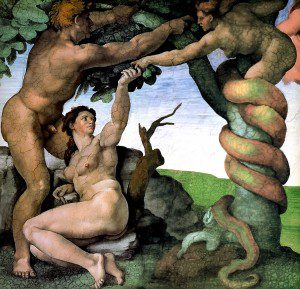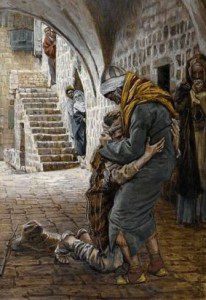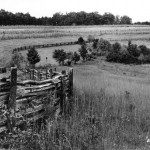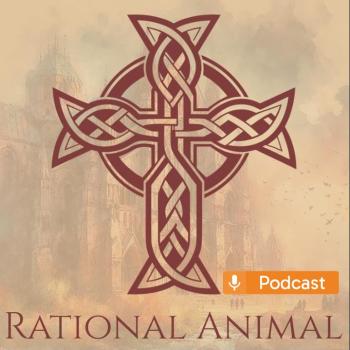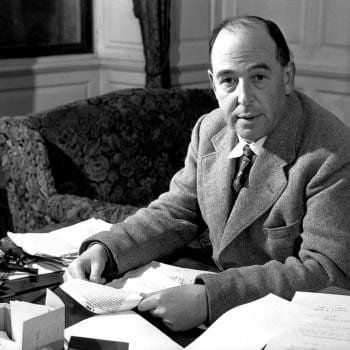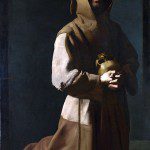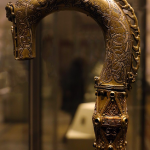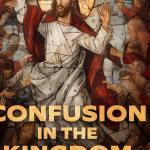The Fall & Expulsion of Adam & Eve
by Michelangelo Buonarroti
Genesis.
Ah, Genesis.
Long ago, I remember wrestling with the story of Genesis. I mean really wrestling. I tortured myself with questions. You know the type of questions I am talking about – the faith-shakers. How long were the days in God’s life? Was a day really a day? Where did dinosaurs fit into the mix of Creation? How about evolution? How old is the earth? Where did Cain and Abel find their wives? How do we explain the wide diversity of race? Were Adam and Eve real or allegorical figures? Did they have bellybuttons? Okay, maybe I just made up that last one. But still. I ruminated. I grappled. I doubted. And one day I approached a pastor (I was Lutheran at the time) and asked about this confounding issue and he simply answered,
“The Creation story is not the hinge upon which faith and salvation rests.”
Whoa. Did he just…? Am I to feel that…? Was there room for…? Whoa. At first it seemed like he said, “What does it matter?” And while initially shocked, over the subsequent years, I was a bit relieved. In the midst of mysterious unanswerables, what was the likelihood that my obsession with jots and tittles would lead to fruitful answers? And yet…while those jots and tittles fell into the acceptable mystery box for me, they upended the faith of people I know and respect. The fact that some people gave up their faith based on these confounding, mysterious unknowns shows me that they are anything but unimportant.
But here’s the thing. If you are thinking about leaving your faith over where Cain and Abel’s wives came from or whether Adam and Eve truly interacted with a talking snake, allow me gently submit a few questions,
Do you believe there is something special about you? Do you feel the same about your spouse, children, best friend or that decent stranger who extended a kind and unexpected courtesy to you? Do you feel similarly about a homeless man sleeping in the gutter and an impoverished naked child with eyes sunken and belly swollen? As unkempt as they are or as unsettling as they seem, do you sense that that person simply shouldn’t be in that position, that it is an injustice, that they deserve better because of who and what they are? In other words, do you have an ill-defined, yet ineradicable sense of the dignity of humankind?
Do you feel that, in spite of your best efforts (and sometimes, suboptimal efforts), you’ve repeatedly succumbed to temptation, made mistakes, felt guilty, strived for improvement and yearned for some deeper form of cleansing (or forgiveness) that allows you to start anew? Have you felt that shortcutting this process (denying ownership of a mistake, papering over the error) is only a fool’s errand that can be rectified only by accepting accountability and seeking grace? In other words, do you have an honest sense of…tragic fallibility and hopeful redemption?
Do you believe that you are made for something important – something that gnaws at you to take care of yourself, do the right thing, try just a little harder and not languish in mediocrity? In other words, do you feel you have (no matter how small) a certain sense of calling?
Do you feel just a bit ill-at-ease where you are and do you seem to always be searching for the place you can rest comfortably and be yourself…only to never quite find it? Do you have a sense for the idyllic, but a difficulty in finding it?
Then you do believe in the Creation story.
For the Creation story offers us a few vital truths – and tells them extraordinarily well. These truths are that we were created, we are special, we were given an extraordinary kind of freedom and calling, we were tempted and screwed up this gift of freedom, we are valuable enough to be rescued from our fallibility but we can’t rescue ourselves, and we remain unsettled until we are fully reconciled – back home – with the One who made us.
That is the Creation story.
And it has little to do with Adam and Eve’s belly buttons.
If you haven’t read the Catholic Catechism – the assembled corpus of Tradition & Scriptural interpretation of the Catholic Church – consider this small gem about the Creation narrative,
“Among all the Scriptural texts about creation, the first three chapters of Genesis occupy a unique place. From a literary standpoint these texts may have had diverse sources. The inspired authors have placed them at the beginning of Scripture to express in their solemn language the truths of creation – its origin and its end in God, its order and goodness, the vocation of man, and finally the drama of sin and the hope of salvation. Read in the light of Christ, within the unity of Sacred Scripture and in the living Tradition of the Church, these texts remain the principal source for catechesis on the mysteries of the “beginning”: creation, fall, and promise of salvation.“
– Catechism of the Catholic Church (289)
(emphasis mine)
When I think about my pastor’s words from years ago, I am not sure I agree with him after all. Perhaps looked at through my older, believing eyes, the Creation narrative has more to do with faith and salvation than I once realized.
After all…we all know dignity and calling. We all know sin and temptation. We all know hope and redemption. And we all know the bittersweet homesickness we feel until the final day when we run with child-like joy and tear-filled eyes into the arms of the Father we have so longed to breathlessly embrace. And who has longed to embrace us.
If we know these truths – if we live daily with this holy understanding – then we truly know the Creation story.
Yes, we do.
How very, very beautiful.
The Return of the Prodigal Son
by James Tissot
Photo credits:
-The Fall & Expulsion from the Garden of Eden by Michelangelo Buonarroti from http://www.the-athenaeum.org/art/detail.php?ID=37535
-Return of the Prodigal Son by James Tissot from https://www.brooklynmuseum.org/opencollection/objects/4538/The_Return_of_the_Prodigal_Son_Le_retour_de_lenfant_prodigue


